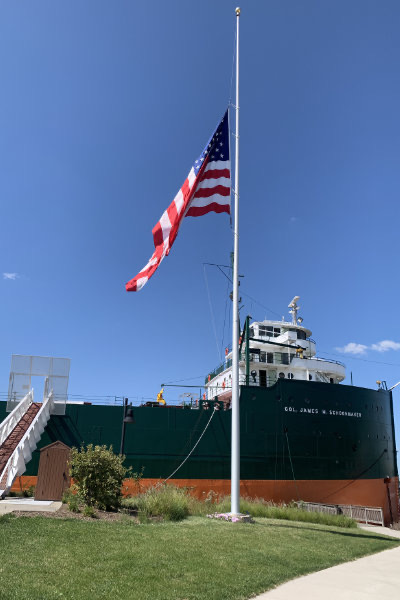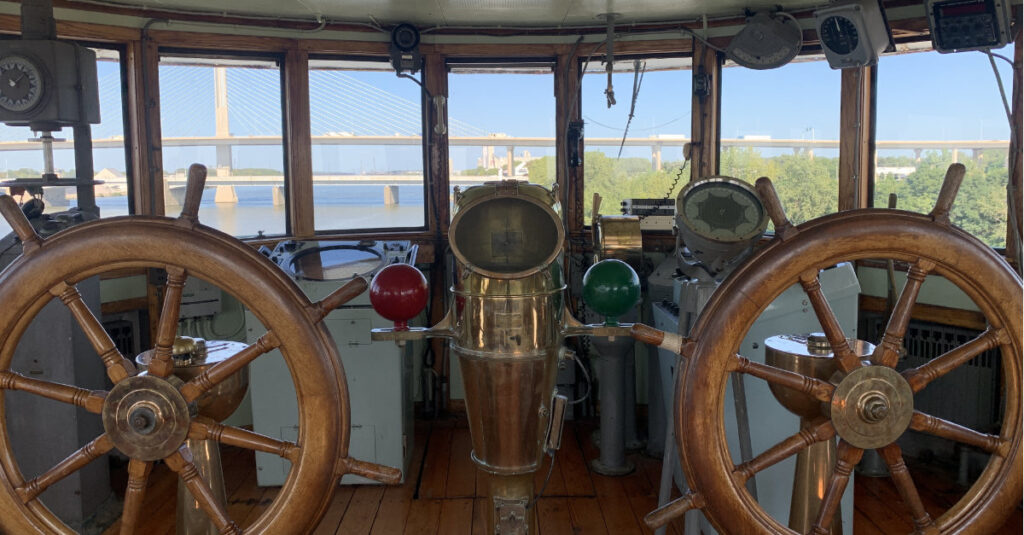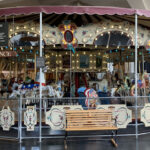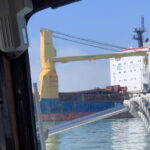September 2, 2021: An easy cruise, a long channel, and a honking huge cargo ship.
We got a later than usual start out of Sandusky Bay, slipping out just before 8 AM. Because the area of the bay we were in had lots of areas with shallow water, we followed the red and green buoys closely, all the way up to the passage under the causeway, where they abruptly ended. From there, we had to guess the best route through a long stretch where the maximum charted water dept was around 8.8 feet. This wasn’t a big deal for Nano, which has a draft of less than 3 feet, but you never really know what might be snagged under the water. Of course, Capt Paul and Dianne had navigated this stretch two days before, but I’d been dead asleep when they did it.
On the Lake
We finally met up with the marked channel that took us past Cedar Point and out into Lake Erie. We were in the west end of the lake now, where a handful of American and Canadian Islands offer some shelter from winds whipping over the lake. It wasn’t particularly windy that day, and the lake waters weren’t rough. But I suspect that opinion is all relative — the rougher the water I experience, the calmer all the other water seems to be.

Here’s a screen grab from Aqua Map showing the islands on the west end of Lake Erie. If you look closely, you can see the yellow dashed lines that mark our path into Sandusky Bay, then out to Toledo, and then on to Detroit the next day.
The main challenge in this area seemed to be the ferries, which darted across between the islands and the mainland at the peninsula north of Sandusky. We saw them coming and going, but only one looked close enough that action might need to be taken. We also saw a lot of very large cabin cruisers — for lack of a better term here — moving between the islands and the mainland.
The autopilot took us on a straight course once we’d passed the islands. After about two hours at the helm, Capt Paul turned the helm over to me. He stayed away for a while at the table doing paperwork and then settled in for a nap. We just chugged along at 10 to 11 knots. I didn’t change course this time; the conditions certainly didn’t give me an excuse to.
Eventually, we caught sight of a structure out in the distance. This turned out to be the Toledo Harbor Lighthouse, which stood about halfway down a very long channel from Toledo out to the lake. Capt Paul had set the autopilot to the red buoy just inland for it. I let the autopilot steer until the track was done, then put it in standby and made the turn into the channel. I then set up the heading hold feature to keep me on a straight course inbound.
Heading hold, by the way, is the autopilot feature we’d used throughout our time in the Erie Canal. Rather than let the system guide the boat on a predefined path — which would be difficult to do safely in such a narrow channel among other traffic — we used heading hold to point the boat in the right direction and then keep it going at that heading until a change was needed. The benefit of this feature is that it made smooth turns and kept us exactly on a course — with manually steering, it was too easy to oversteer or understeer, requiring constant adjustments. This worked really well throughout the canal, although I preferred to manually steer in areas where the canal did a lot of twisting and turning.
The channel took us down a straight, dredged path between areas of shallow water. Toledo is a deep water port, so although we didn’t need much water under the boat, the tankers and cargo ships that came in did. But there were no big ships using the channel that day. Just more of the large cabin cruisers and a handful of smaller fishing boats, all of which blew past us on their way in or out.
Capt Paul woke up before we got into the part of the channel where there’s land on both sides — the Maumee River. I had only a vague idea of where we were going, so I stepped down and let him take us the rest of the way. We passed under one train trestle with a 20-foot clearance and through another trestle that had been left open. The area on either side of us was mostly industrial. We slipped under two bridges — the high Glass Memorial Bridge with freeway traffic on it and the much lower Craig Memorial Bridge. Then the Skyway Marina was on our left and Capt Paul motored us in.

The second bridge on the Maumee River is a railroad swing bridge that is left open.
The dock guy came out as we approached. He told us to take slip 13 or 14 — our choice. Then he grabbed a hose and started clearing goose and seagull poop off the dock beside where we’d park. Capt Paul backed us in and Dianne and I tied us up. We ran the power cable to the connector on shore and were set up before Capt Paul shut down the engine. By this point — more than 3 weeks into the trip — we had it down to a science.

Our Nebo Log for Day 24 of my trip. We had finally reached the end of Lake Erie.
At Toledo
We were all very hungry and, after getting key cards for the gate and restrooms, headed off in search of lunch. The dock guy was weird — he offered to drive us to his favorite place, which wasn’t far from the place we were considering, but when we said yes he somehow thought we said no and he went back into his office. Okay. So we walked the 0.7 miles to a place called Michael’s, a restaurant/cafe that was a bit disappointing in ambiance but made good sandwiches and a killer pecan sandy cookie. Then we had to walk back.
I’ve been wanting very much to do some walking for exercise and, unfortunately, both Paul and Dianne walk at a much slower pace than I need to get my heart going. So I made my own pace on the way back and beat them by a good five minutes.

The entrance to the Col. James M. Schoonmaker, a meticulously restored iron ore freighter.
We’d planned to visit the National Museum of the Great Lakes, which was actually at our marina. They had a large cargo ship and tugboat tied up there, ready for self-guided tours. I went directly into the museum to wait for Paul, who I knew also wanted to see the ship. It was getting close to 3 PM and the ship tours ended at 4. I wound up waiting at least 15 minutes in the air conditioned comfort of the museum area. That’s when Paul and Dianne both showed up. Dianne bought a ticket for just the museum, while Paul and I got tickets for the whole shebang and immediately went out to the cargo ship.
The tour was amazing, partly because I downloaded an audio tour app created just for it. As we walked to various places in the ship, I played the corresponding audio from my phone. Each segment was just long enough to be interesting without going on too long. The ship itself was amazing and I highly recommend touring it if you’re ever in Toledo. If you can’t go, try checking out the virtual tour on the museum’s website. Totally worth it.

The engine room in the Schoonmaker. The entire area was open to walk around in.

The bridge up on the Schoonmaker. This was the last stop on the tour.
It was 4 PM by the time we were finished. Not only were we both exhausted from walking so far that warm day, but the ships were closed to more tours. So we missed out on the tugboat. And I’ll be honest — I had no desire to visit yet another nautical themed museum.
Restful Evening
Back at Nano, I got to work on my never-ending chore of getting this blog up to date. I wrote and published Day 17‘s account.
I also launched my drone a little before sunset. The first flight was a little scary because seagulls took an immediate interest in it and more than one of them flew very close. I landed it immediately — I really don’t want to lose another drone in a body of water. But I also wanted photos so I launched it again, zipped it into position, and shot two photos of the marina with the cargo ship, museum, and bridge beyond. Then I landed it quickly before those gulls took an interest again.

Here’s one of the two drone shots I took that afternoon at the marina.
My shipmates hit the sack early. I took a walk out to the restrooms, wondering where the automatic lighting we’d been told about was installed. Just two lights went on for me, but they were enough to find my way into the building. When I came out, I spent some time looking at the way things were all lit up. The Glass Memorial Bridge had colored lights on the towers and lights along the supporting wires. I walked around the building, savoring the quiet and solitude, taking a few photos.

The Glass Memorial Bridge, at night.
I was plenty tired when I hit the sack.


